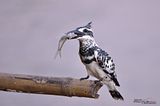Now I'm back in Thailand again after a short trip to Osaka and Kyoto. I totally fell in love with the latter, but wasn't quite fond of the former. Much of Kyoto reminded me of my hometown, Chiang Mai, a mix of old and new landscapes and lifestyles, except that it's much better organised. My dead camera has finally been replaced with a new 550D. Sad news, it couldn't be fixed... I actually wanted to do more posts here, but just didn't have the time and energy to do it. Even after coming back to Thailand, there are still things that keep me busy for most of the time. Tonight, I'm just going to post some old photos I took during the last spring vacation in Thailand in early March.





Female and juvenile Spot-winged Grosbeaks (Mycerobas melanozanthos)
 These photos of the Spot-winged Grosbeaks (Mycerobas melanozanthos) were photographed by my old 350D at Fang Hotspring, north of Chiang Mai city on March 5, 2011. The hot spring is well-known among birders as the place where this scarce species can be regularly seen. The hot spring has always been a regular site for this beautiful grosbeaks for many decades and still continue to be so, despite the development and changes of the landscape and the increasing number of tourists. They can be found during dry season, from December to March, gathering in flocks ranging from 10 to over 60 birds.
These photos of the Spot-winged Grosbeaks (Mycerobas melanozanthos) were photographed by my old 350D at Fang Hotspring, north of Chiang Mai city on March 5, 2011. The hot spring is well-known among birders as the place where this scarce species can be regularly seen. The hot spring has always been a regular site for this beautiful grosbeaks for many decades and still continue to be so, despite the development and changes of the landscape and the increasing number of tourists. They can be found during dry season, from December to March, gathering in flocks ranging from 10 to over 60 birds.


Male Spot-winged Grosbeaks (Mycerobas melanozanthos)
The reason why they always come to the hot spring is obvious, to obtain salt and other important elements including sulphite and peroxide. Trees surrounding the hot springs are covered with white substance, which is eaten by the grosbeaks. From the research, the birds mostly obtain salt, averagely 465 mg/litre, sulphite 25.71 mg/litre, peroxide 0.33 mg/litre with the average pH of 9.24, indicating basic which might help balancing the body pH after consuming acidic fruits. Sulphite helps the growth of feathers, bill and bones, and effects the anabolism in the process of generating ATP.



















.jpg)

2 comments:
Great looking bird.............
I thought you would have bought a 5D MK2!!!!!!!!!!!
I'd love to, but unfortunately can't afford it!
Post a Comment